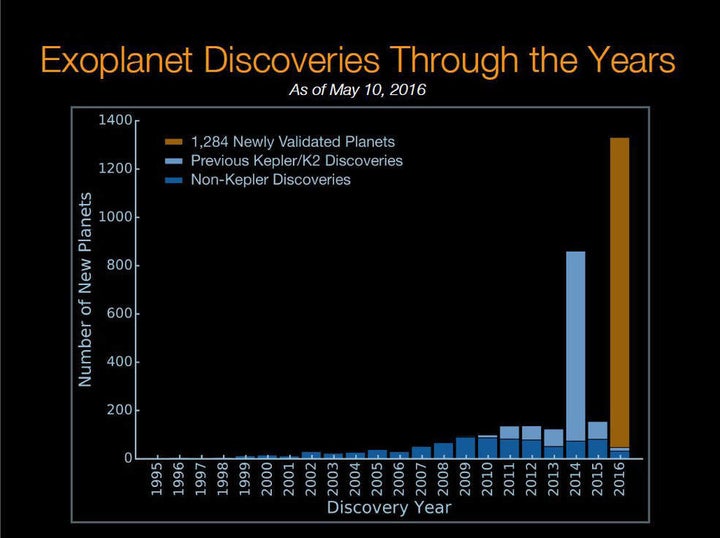NASA astronomers have identified 1,284 previously undetected planets, including nine that may be habitable -- the biggest collection of planets ever discovered, the space agency said Tuesday.
The powerful Kepler telescope, which seeks to find Earth-like planets, spotted the exoplanets, or worlds outside of our solar system. About 550 may be rocky, like Earth, while nine could have surface temperatures allowing liquid water.
"This gives us hope that somewhere out there, around a star much like ours, we can eventually discover another Earth," NASA's chief scientist, Ellen Stofan, said in a statement.
NASA's announcement was remarkable because of the size of the discovery. It more than doubled the list of known exoplanets.
Scientists discovered the first exoplanet in 1992, but there has been an explosion in the number that have been located since Kepler's launch in 2009. More than 3,200 verified planets exist, according to NASA, and the Kepler mission spotted 2,325 of them. Kepler scans 150,000 stars for evidence of planetary forms.

The discoveries are made possible by a statistical breakthrough that speeds the verification process for new planets, according to NASA.
The Kepler telescope monitors distant stars for changes in their brightness. A star that partially dims suggests that some celestial body, such as a planet, had passed in front of it -- similar to the technique that showed Mercury traveling in front of the sun on Monday. After these suspicious areas are identified, astronomers take further measurements.
Rather than a "laborious, one-by-one process," NASA said the new statistical method allows it to simultaneously authenticate the presence of multiple planets.
For each of the 1,284 newly discovered bodies, there is at least a 99 percent probability that it is a planet rather than some other object, according to NASA's analysis. An additional 1,327 bodies are likely to be planets, but they didn't meet the 99-percent threshold for verification, NASA said.
"Before the Kepler space telescope launched, we did not know whether exoplanets were rare or common in the galaxy," said NASA Astrophysics Director Paul Herz. "Thanks to Kepler and the research community, we now know there could be more planets than stars,”
The research was published in The Astrophysical Journal.
Counting the nine potentially habitable planets announced Tuesday, there are 21 known planets in the so-called Goldilocks zone that is neither too hot nor too cold to sustain life, according to Agence France-Presse. The nearest is about 11 light years away, which is astronomically close, but still far beyond the reach of any manmade spacecraft.
